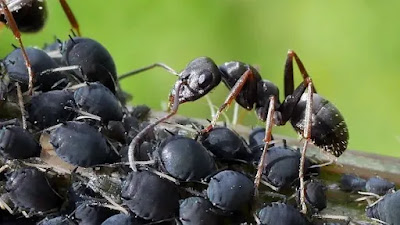The aphids are probably best known as "greenfly or "black- fly and are found on the succulent growing points ol many plants including citrus and beans. They belong to a group o insects known as "bugs" or Hemiptera, the mouth parts ot which are modified to form piercing and sucking tubes, the insects obtaining their food by sucking plant juices or the blood of other animals. Water scorpions are Hemipterans which prey on other pond creatures; the frog hoppers and cicadas draw fluids from plants. This group of insects has an incomplete metamorphosis: there is no pupal stage, but instead the nymph undergoes a series of moults in which it gradually becomes mature. There are over 400 species and varieties of aphids.
Life history. In favourable conditions aphids reproduce very rapidly by a process called viviparity. Viviparity is the production of young without laying eggs, e.g. most mammals are viviparous. In aphids the eggs develop into nymphs inside the body of the female and are ejected from the genital opening each wrapped in a thin egg membrane, at the rate of about three per day. The young insects are very similar to the adults, with three pairs of legs, compound eyes and antennae.
The nymphs feed on the shoots and leaves of the plant on which they are born and they grow to maturity, shedding their cuticles several times. There are po larval or pupal stages comparable to those of the butterfly, but in about a week, with successive moults the nymphs become mature and start producing offspring viviparously. While food is abundant, only wingless females are produced but the short reproductive cycle soon results in a very large colony of aphids on the plant. When the shoot becomes overcrowded and the leaves begin to die as a result of excessive removal of sap.
some of the nymphs develop external wing pads which grow larger at each moult, giving rise to two pairs of wings in the adult. The winged forms fly to a Irish plant and produce wingless daughters viviparously.
The winged forms have two pairs of wings, the hind pair quite small, which are transparent with few veins. The aphids are not strong fliers but tend to be carried by chance air currents rather than make direct flights During favourable periods, e.g the rainy season, when viviparous young are being produced, there are no male aphids
present in the colonies. This means that the eggs must develop in the female without being fertilized, a process called parthenogenesis. In temperate climates, males appear among the viviparous offspring in October. In tropical regions the males appear just beford conditions. The males mate with wingless females who lay eggs usually on the twigs of a tree or shrub. The eggs are thick- shelled and resistant and are the means by which the aphid survives drought and extremes of temperature. With the return of favourable conditions, the eggs hatch to wingless females which begin the parthenogenetic cycle again.
Feeding habits. Nymphs and adults feed in the same way. Their mouth parts consist of a slender tube with two sharp stylets running down each side. All these are enclosed in the sheath-like labium and are held horizontally below the thorax when not in use. During feeding the labium is bent and shortened as the stylets and central tube are pushed through the epidermis of the leaf or stem until they reach the sieve tubes of the phloem in a vascular bundle. Saliva is injected through the puncture to begin the digestion of the sap and protoplasm, and the fluids are then pumped up by muscular movements of the gullet into the alimentary canal. The fluid pressure existing in most plant cells probably assists the flow of liquid through the aphid's mouth parts. In fact, a standard technique for analysing the contents of sieve tubes is to cut off the proboscis of a feeding aphid and collect the fluid that continues to exude from the cut end. Most aphids seem to take in from the plant sap more sugar than they can assimilate, so that their faeces consist of a sweet syrup, honey dew, that is passed out of the anus. Some species of ant like to feed on this exudation and may be seen clambering over the colonies of aphids on nettles and other plants to collect it.
Other species of ants "farm aphids by keeping them in the nest below ground where they suck fluids from roots, the ants then collecting the honey dew as it is egested.
Damage and control. A large number of aphids on the growing shoots of a plant, such as citrus and cotton can cause damage, partly by the excessive removal of food that would otherwise pass to the growing leaves, partly by the digestive action of the saliva injected and also by introducing virus diseases from one plant to another, e.g. swollen shoot virus of cocoa. Young leaves attacked by aphids usually curl up and wither and the growth of the entire shoot may be arrested.
Aphids can be destroyed by spraying them with solutions or suspensions containing derTIS, BHC or "Gammexane, which kill them on contact. Covering the leaves with poisons is useless because the aphid draws its food from below the surface. Once the leaves have curled up under a heavy aphid attack it is difficult to reach the insects with sprays.
Larval and adult ladybirds eat a great many aphids, and an ichneumonid parasite causes many deaths by laying its eggs in the bodies of the aphids in a similar way to the ichneumon which parasitizes the Papilio caterpillar. These predators and parasites help keep down the numbers of aphids.


